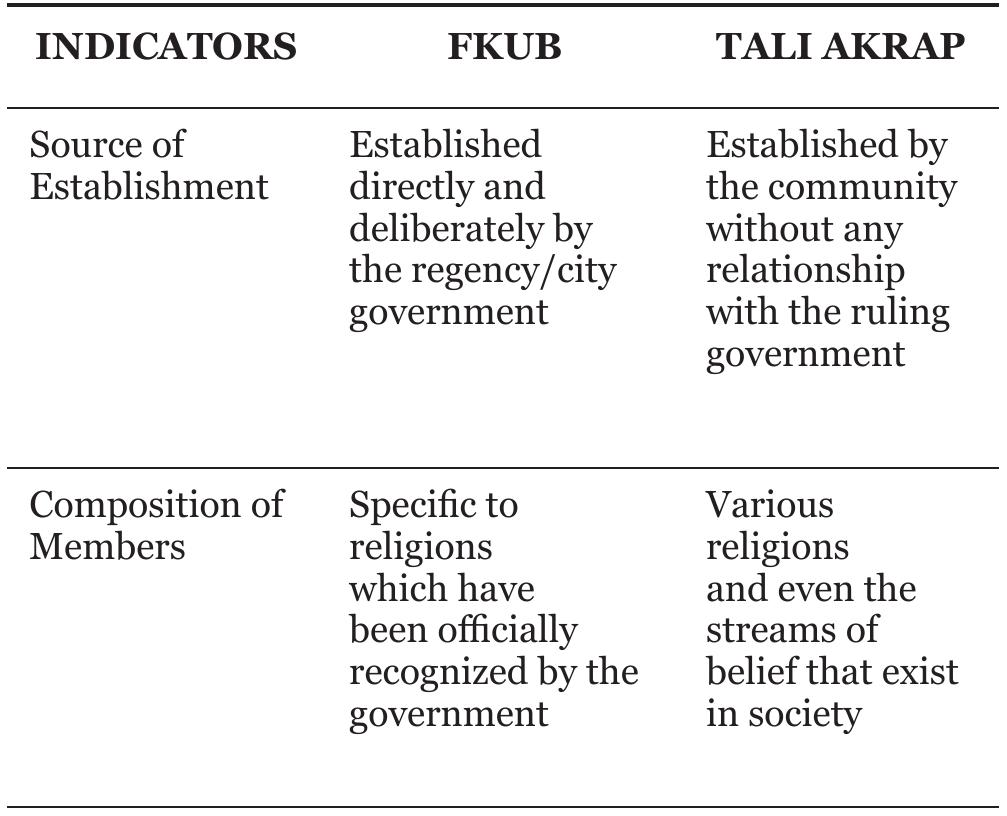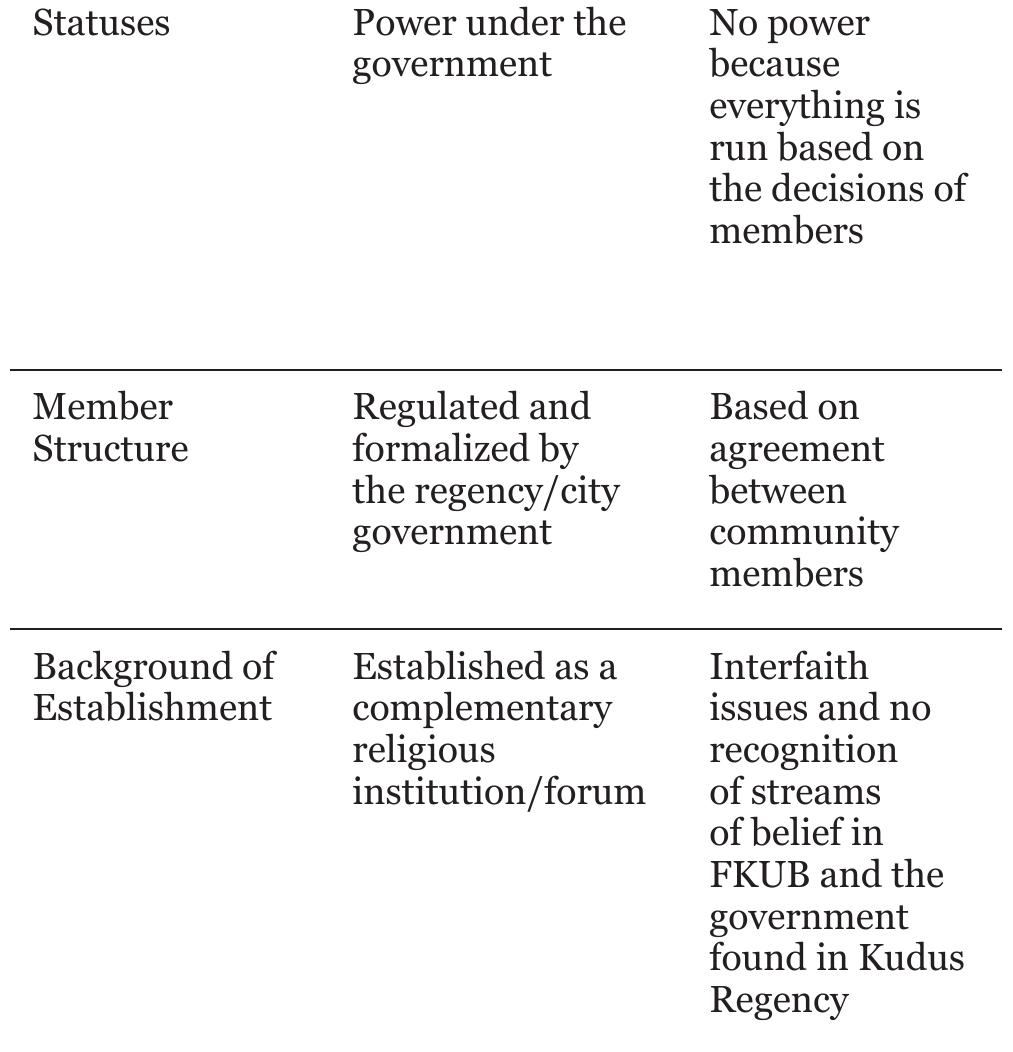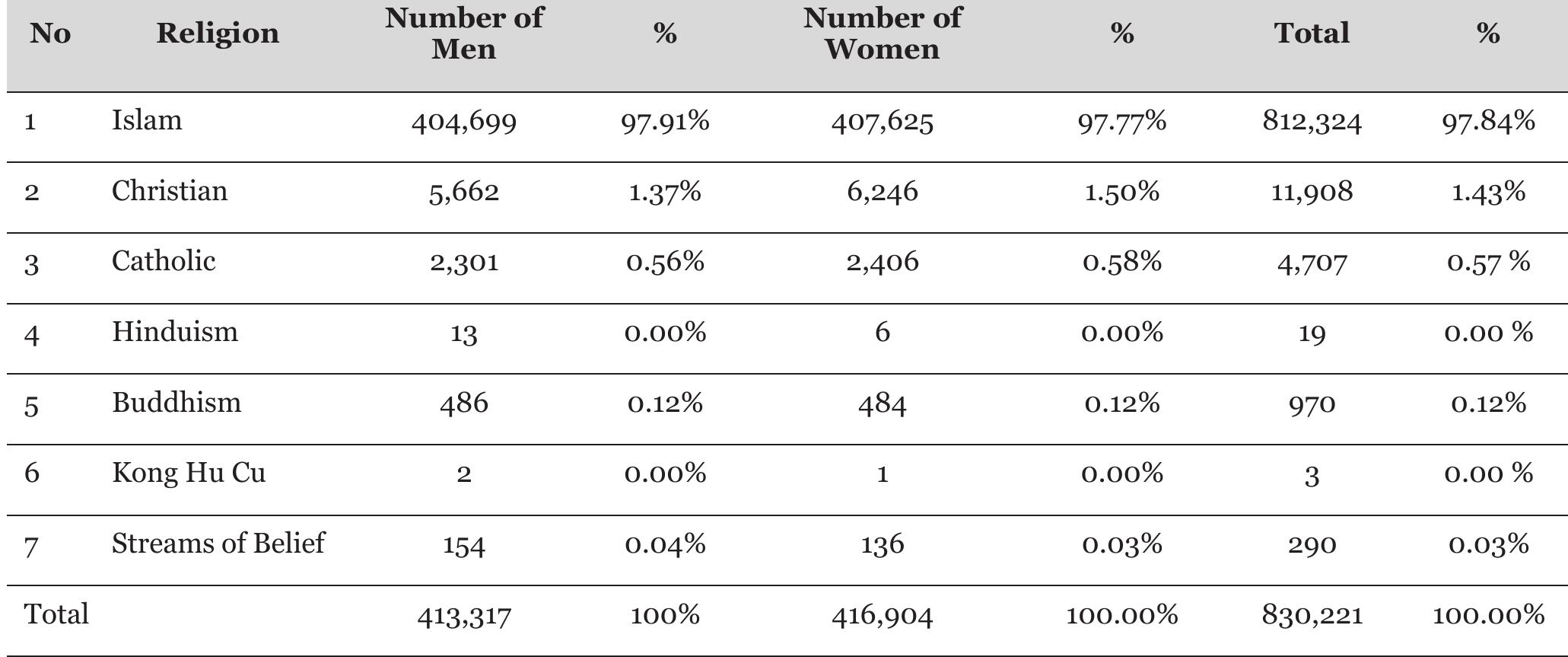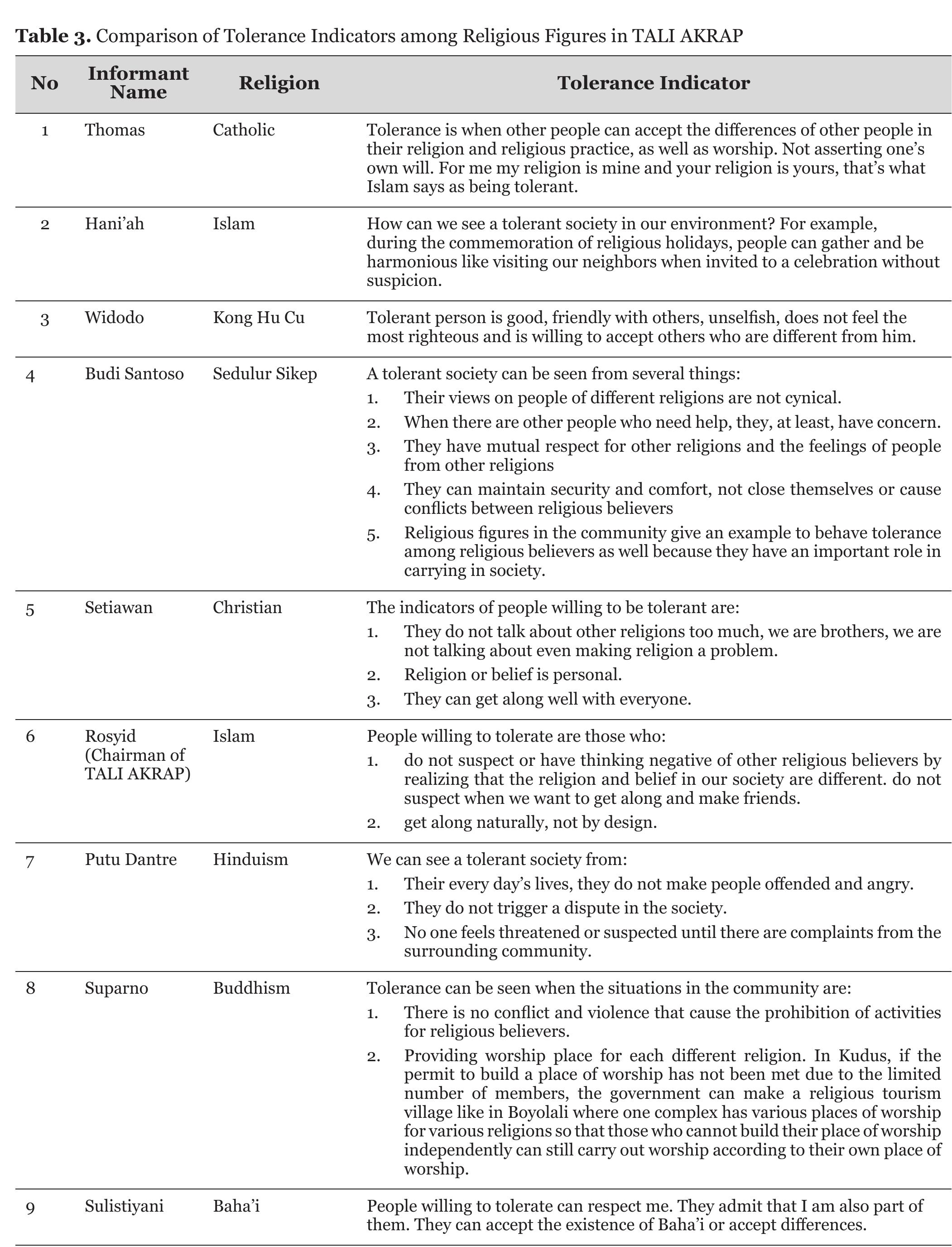Dialog of Interfaith and Interbelief Communities of Pantura (Tali Akrap): An Overview from the Structural Functional Theory (original) (raw)
Abstract
Interfaith dialog is commonly carried out to harmonize the relationship and minimize conflicts between religious believers. This study examines how the functional structure of an interfaith community and beliefs can create harmonious interfaith relationship through an interfaith dialog held in Kudus, Central Java. This study is designed with qualitative research model by applying the phenomenological approach. The data were technically collected through interviews, observation, document studies and Focus Group Discussion (FGD). Theoretically, this study used Talcott Parsons’ structural functional theory. The results showed that the Interfaith and Interbelief Communities of Pantura (TALI AKRAP) is a system in society where the religious adherents and the flow of beliefs are the integrated elements, each of which should function one another in creating a balance in society. As a system, TALI AKRAP holds four imperative functions which are simultaneously integrated in action systems, ...
FAQs
AI
What were the main challenges faced by TALI AKRAP in interfaith dialogue?add
Data indicates that TALI AKRAP confronted challenges such as prejudice from various communities, and diverse interpretations of religious teachings, which complicate true dialog. These obstacles highlight the necessity for continuous education and community engagement for better mutual understanding.
What role does structural functional theory play in understanding TALI AKRAP's activities?add
The paper applies structural functional theory to showcase how TALI AKRAP serves as a social system integrating religious diversity, fostering stability through community dialog. This underscored how interdependencies among group members facilitate collective goals toward societal harmony.
How does TALI AKRAP's dialog model differ from government-established frameworks?add
TALI AKRAP includes various streams of belief often excluded by government bodies like FKUB, providing a more inclusive platform for interfaith discussions. It emphasizes community-based solutions over formal authority, making it more adaptable to local social dynamics.
What data collection methods were employed in this study on TALI AKRAP?add
The research utilized qualitative methods including purposive sampling, in-depth interviews, focus group discussions, and participatory observation to gather a comprehensive understanding of interfaith dynamics. This multifaceted approach enabled a richer dialogue across diverse community perspectives.
What were the impacts of TALI AKRAP's interfaith dialog on its members?add
The interfaith dialog significantly enhanced members' recognition and acceptance of diverse beliefs, fostering a greater sense of community and understanding. Reports indicated improved intergroup relationships, particularly for minority religious groups, reflecting increased social cohesion.
Figures (5)
Source: Discussion Situation for FGD Implementa- tion According to Bungin, 2011 Forum of the Discussion Group Model Figure 1
Table 1. Comparison between FKUB and TALI AKRAP streams of belief or new religions such as the Baha’ religion do not get space in FKUB. They are included in cultural groups in the Regency Tourism and Culture Office. The case may not solely be whether TALI AKRAP is included in FKUB. For new religions like the Baha’i religion, they might not be incorporated into a regency scale interfaith platform, given that not every regency/ city area has an interfaith community forum. Thus, the existence of TALI AKRAP, which constitutes not only interfaith but also inter-regions, is welcomed with great enthusiasm by interfaith leaders who are open to other religions. TALI AKRAP established by the community constitutes of various representatives of religious figures and religious beliefs. They move on concerns about the lack of tolerance between religious communities, especially, because there is more or less a difference in the treatment of religious people under government-madecommunities compared to naturally made ones. In practice, TALI AKRAP moves through communal activities or interfaith dialogs in achieving the community’s- oriented goals by embracing various religions and streams of belief. To distinguish between people’s communities and government-made communities, in more detail the following table will illustrate the differences between FKUB and TALI AKRAP; Table 1. Comparison between FKUB and TALI AWDNDAT)
Source: Researcher’s personal interview and docu- mentation Dialog of Interfaith and Interbelief Communities of Pantura (Tali Akrap): An Overview From The Structural Functional Theory Ama Farida Sari, Rusnaini, and Triana Rejekiningsih The different characteristics of society and the diversity of religions and the streams of belief may lead to gaps, conflicts in addition to the lack of tolerance between religious believers due to the high level of extreme interpretation of each religion, the unwillingness of religious people to live a harmonious social life with other religious communities, and even to the conflict of interests each individually. In view of this, there needs to be a platform for unifying religious differences which is carried out not only by one religion but all including the streams of belief that exist in society through a communication or dialog between religious believers. Through the interfaith communication or dialog, problems between religious believers and negative views on certain religions or streams of belief can be minimized and tolerance between religious believers can be realized. eM a ee) ny i’ a ae ge en ee eo SS —
Source: Central Java Information and Communication Office, 2016 Table 2. Total Population of Kudus Regency in 2016 Based on Religion and Belief
Source: Interviews and private documentation of the researcher

Loading Preview
Sorry, preview is currently unavailable. You can download the paper by clicking the button above.
References (19)
- Anshorie, Asep. 2015. Peranan Komunikasi Kelompok dalam Menciptakan Keharmonisan antar Anggota Komunitas Pengajian Barokah Sekumpul Mushola Ar-Raudah Loa Bakung Samarinda. eJournal Ilmu Komunikasi, 3 (4):361-371
- Bazezew, Arega and Mulugeta Neka. 2017. Interpersonal Conflicts and Styles of Managing Conflicts among Students at Bahir Dar University, Ethiopia. Journal of Student Affairs in Africa, 5 (1): 27-39, DOI: 10.14426/jsaa.v5i1.2480
- Bungin, Burhan. 2011. Penelitian kualitatif: Komunikasi, Ekonomi, Kebijakan Publik, dan Ilmu Sosial Lainnya. Jakarta: Kencana Prenada Media Group Casram.2016. Membangun Sikap Toleransi Beragama dalam Masyarakat Plural. Wawasan: Jurnal Ilmiah Agama dan Sosial Budaya 1, 2 Juli 2016 halaman 187-198
- Daeng, Hans. J. 2000. Manusia, Kebudayaan dan Lingkungan. Yogyakarta: Pustaka Pelajar Offset
- Haryanto, Sindung. 2012. Spektrum Teori Sosial. Yogyakarta: Ar-Ruzz Media
- Herdiansyah, Haris. 2012. Metodologi Penelitian Kualitatif untuk Ilmu-Ilmu Sosial. Jakarta: Salemba Humanika
- Ismail, Faisal. 2014. Dinamika Kerukunan Umat Beragama. Bandung: PT. Remaja Rosdakarya Offset Khotimah. 2011. Dialog dan Kerukunan Antar Umat Beragama. Jurnal Ushuluddin, XVII (2): 214-224
- Moleong, L. 2006. Metodologi Penelitian Kualitatif. Bandung: PT. Remaja Rosdakarya Offset Liliweri, Alo. 2007. Dasar-Dasar Komunikasi Antar Budaya. Yogyakarta: Pustaka Pelajar Offset
- Liliweri, Alo. 2011a. Komunikasi Serba Ada Serba Makna. Jakarta: Kencana Prenada Media Group
- Liliweri, Alo. 2011b. Gatra-Gatra Komunikasi Antarbudaya. Yogyakarta: Pustaka Pelajar
- Raho, Bernard. 2007. Teori Sosiologi Modern. Jakarta: Prestasi Pustaka Retnowati. 2014. "Agama, Konflik, dan Integrasi Sosial (Integrasi Sosial Pasca Konflik Situbondo). Analisa: Journal of Social Science and Religion, 21 (02): 189-200
- Ritzer, George. 2012. Teori Sosiologi. Yogyakarta: Pustaka Pelajar
- Rosyid, Moh. 2013. Harmoni Kehidupan Sosial Beda Agama dan Aliran di Kudus. Jurnal ADDIN, 7 (1): 41-64
- Rosyid, Moh. 2015. "Mewujudkan Pendidikan Toleransi Antar-Umat Beragama di Kudus: Belajar dari Konflik Tolikara Papua 1 Syawal 1436 H/ 2015 M." Jurnal Pendidikan Islam Quality, 3 (2): 369-409
- Rusnaini. 2013. Pendekatan Socio-Cultural Development dan Socio-Political Intervension Untuk Mengatasi Konflik Sosial Sebagai Upaya Memantapkan Ketahanan Wilayah di Surakarta." Jurnal Ketahanan Nasional", XIX (2): 79-89
- Rozak, Abdul. 2008. Komunikasi Lintas Agama: Modal Sosial Pembentukan Masyarakat Sipil. Jurnal Dakwah, Vol. IX No. 1, Januari-Juni 2008, halaman 13-28
- Setiadi, Elly M and Kolip, Usman. 2011. Pengantar Sosiologi. Jakarta: Kencana Prenada Media Group Sigalingging, Hamonangan. 2008. Buku Ajar Pendidikan Kewarganegaraan, Jurusan Politik dan Kewarganegaraan. Semarang: FIS Unnes Press Sugiyono. 2009. Metode Penelitian Kuantitatif, Kualitatif dan R&D. Bandung: Alfabeta Surat Keputusan KEMENKUM HAM RI No. AHU-0013488.AH.01.07 Tahun 2015, KESBANGPOL Kudus No. 220/561/20/2016
- Tutiasri, Ririn Puspita. 2016. Komunikasi dalam Komunikasi Kelompok. Jurnal Channel, Vol. 4, No. 1, April 2016, p. 81-90
- Undang-Undang Dasar 1945 Amandemen




